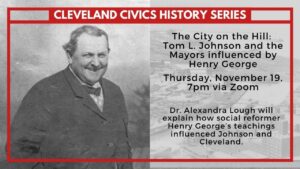Marcus Hanna and his epic clashes with Tom L. Johnson:
Podcast from the Music Box
2/29/2024
w/Ryan Chamberlain and Dr. John Grabowski
Category: Tom L. Johnson
{gallery}progressive_era/johnson{/gallery}

THE GREAT AMERICAN PARADOX:
TOM L. JOHNSON AND THE CONTROVERSY
SURROUNDING HIS ROLE IN HISTORY
A Thesis
Presented in Partial Fulfillment of the Requirements
for the Degree Master of Arts
by
Eric Charles Lewandowski, A.B.
The Ohio State University
The Tom L. Johnson Testimonial Banquet, May 31, 1910
The Tom L. Johnson Testimonial Banquet, May 31, 1910
Program from the testimonial given for Tom L. Johnson on May 31, 1910 in New York City just prior to his death in 1911
Issue 1 aims at the heart of Ohioans’ citizen initiative powers. Here’s how we won them: Mike Curtin cleveland.com July 9, 2023

Issue 1 aims at the heart of Ohioans’ citizen initiative powers. Here’s how we won them
“As the stench of corruption worsened, Ohio produced more strong reform leaders than any other state. Most notable were the Rev. Herbert S. Bigelow of Cincinnati’s Vine Street Congregational Church, Cleveland Mayor Tom L. Johnson, the Rev. Washington Gladden of the First Congregational Church of Columbus, and Toledo Mayor Samuel M. “Golden Rule” Jones.”
by Mike Curtin
“A Man is Passing” Poem written on the death of CLE Mayor Tom L Johnson 1912 by Edmund Vance Cooke
A man is passing: Ode to Tom L Johnson by Edmund Vance Cooke (1912)

Tom L. Johnson’s Tax School: The Fight for Democracy and Control of Cleveland’s Tax Machinery by Andrew L Whitehair
Tom L. Johnson’s Tax School: The Fight for Democracy and Control of Cleveland’s Tax Machinery
by Andrew L Whitehair, 2020, Master of Arts in History, Cleveland State University, College of Liberal Arts and Social Sciences.
Prior to Tom L. Johnson’s election to mayor of Cleveland in 1901, the city’s tax system was rife with inequality. Johnson sought to correct these inequalities by democratizing Cleveland’s tax system. To accomplish this aim, he established a new department in City Hall, called the “tax school,” which was designed to educate Clevelanders about the existing tax system’s failures as well as Johnson’s proposed solutions. The tax school worked to improve the tax assessment process by implementing a scientific approach, improving transparency, and soliciting citizen input. Johnson’s efforts, however, met with resistance from an entrenched business elite that employed the state legislature and courts to destroy Johnson’s tax school. Through political campaigns of misinformation, usurpation of the primary process, and stuffing key tax institutions with friendly partisans, these business elites conspired to control the tax machinery of Cuyahoga County. This study of Johnson’s efforts to democratically reform Cleveland’s tax system reveals how the city’s business elite colluded to destroy the tax school and to retain the levers of tax power. In providing the canonical account of Cleveland’s tax school, I situate the history of the tax school within a multi-party negotiation governed by unequal power relationships between business elites and the rest of society. The wealthiest Clevelanders possessed the greatest access to the tax system, and they used that access to rig the system in their favor.
Thomas Suddes talks about Cleveland Government of Tom L. Johnson and the “Public Interest”
(Interview from 2012)
The City on the Hill: Tom L. Johnson and the Mayors influenced by Henry George Thursday, November 19, 7pm

The City on the Hill: Tom L. Johnson and the Mayors influenced by Henry George
Thursday, November 19, 7pm
A talk by Dr. Alexandra W. Lough, author of The Last Tax: Henry George and the Social Politics of Land Reform in the Gilded Age and Progressive Era
Cleveland during the period of Mayor Tom L. Johnson (1901-1909) was considered by many to be one of the best governed cities in the nation. But Johnson was just one of several mayors who were followers of the 19th century political economist and social reformer Henry George. Dr. Alexandra Lough will explain how the teachings of Henry George influenced Tom L. Johnson’s mayoralty in Cleveland.
The video is here
This series is cosponsored by Cleveland History Center, CWRU Siegal Lifelong Learning and the League of Women Voters of Greater Cleveland
Photo: Cleveland Press Collection
TOM L. JOHNSON’S TAX SCHOOL: THE FIGHT FOR DEMOCRACY AND CONTROL OF CLEVELAND’S TAX MACHINERY – Masters Thesis by ANDREW L. WHITEHAIR
TOM L. JOHNSON’S TAX SCHOOL: THE FIGHT FOR DEMOCRACY AND CONTROL OF CLEVELAND’S TAX MACHINERY
by ANDREW L. WHITEHAIR
The link is here
If that link does not work, try this
Bachelor of Science in Business Administration Washington University in St. Louis
May 2003
Master of Science in Business Administration Washington University in St. Louis December 2003
2020, Master of Arts in History, Cleveland State University, College of Liberal Arts and Social Sciences.


